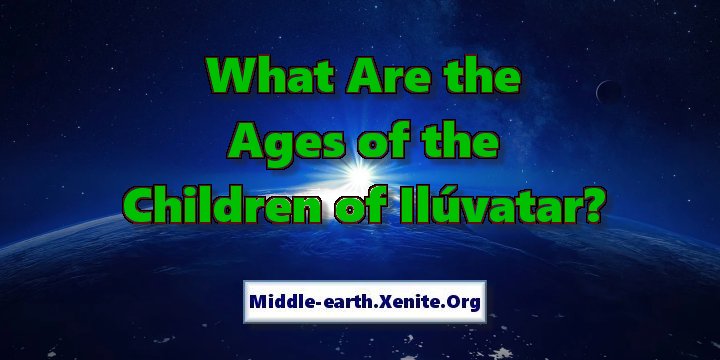
Q: What Are the Ages of the Children of Ilúvatar?
ANSWER: The “Ages of the Children of Ilúvatar” is a fannish convention modeled on an expression that J.R.R. Tolkien used in an early version (B) of his tale of years for the First Age (published in The War of the Jewels, Volume XI of The History of Middle-earth) and in “The Annals of Aman”. A note attached to Version B of the “Tale of Years” in The War of the Jewels (Volume XI of The History of Middle-earth) reads:
600. This final entry was changed to 590, and the following was added to it: ‘Morgoth is thrust from Arda into the Outer Dark.’ ‘Here ends the First Age of the Children of Ilúvatar’ was changed to: ‘Here end the Elder Days with the passing of Melkor, according to the reckoning of most lore-masters; here ends also the First Age…’
Subsequent revisions to the tale of years did not restore the original wording. There is a long-standing, widespread misunderstanding about how to refer to the various “ages” Tolkien mentions or describes in his literature.
For example, The Silmarillion says that the “ages of the stars were ended” with the coming of Fingolfin to Hithlum (when the Sun first arose). The “ages of the stars” do not coincide with the ages measured in “years of the Trees”. There is no precise definition for “ages of the stars” but there are “ages uncounted and forgotten” that began with the entry of the Valar into the halls of Eä.
There were also the “three ages” of Melkor’s imprisonment in the Halls of Mandos, which were each measured as 100 years of the Trees (but this measurement is not included in The Silmarillion — it was published in Morgoth’s Ring, Volume X of The History of Middle-earth, and was equivalent with “an age of the Valar”). There are passages that mention “first age of the Chaining of Melkor”, “second age of the captivity of Melkor”, etc.
Christopher Tolkien wrote in the “Foreword” to The Silmarillion: “The Silmarillion, now published four years after the death of its author, is an account of the Elder Days, or the First Age of the World.”
In The Silmarillion, “Of the Rings of Power and the Third Age” includes the following: “Thus began the Third Age of the World, after the Eldest Days and the Black Years;….” Of course, “the Black Years” do not correspond to any calendrical “age” — they are, instead, the years that follow the War of the Elves and Sauron — also called “the Days of Flight” — in which many Elves left Middle-earth forever.
The Lord of the Rings uses “age of the world” in various passages. The final expression as used by Tolkien thus appears to be “age(s) of the world”, but these “ages” are not consistently denoted. For example, “the First Age of the World” corresponds to the Elder Days, which term Tolkien himself used inconsistently (in The Lord of the Rings he says it applied to all the years leading up to the end of the Third Age but was often used only of the First Age). “Elder Days” seems to correspond approximately to all the time passing from the Awakening of the Elves onward, which event predated the creation of any calendar systems by the Elves (though it was included through backward dating by Elvish loremasters).
At least three calendar systems are used to document the events leading from the Awakening of the Elves to the defeat of Melkor; hence, we cannot say that “the First Age of the World” corresponds to any calendaric span of years, for the Years of the Trees ended with the deaths of the Trees and the Years of the Sun only began with the rising of the Sun. The time in-between could best be called “Days of the Moon”, but was nonetheless still part of “the ages of the stars”.
Tolkien’s use of “age of the world” may be no more than an attempt to settle upon a sufficiently archaic-sounding expression; on the other hand, it might represent an esoteric point of view concerning the difference in nature between the Ainur and the Children of Ilúvatar. In some contexts, “the world” is used to refer to all the people of Earth — our collective society — and not the Earth itself. Since the Elves, Dwarves, and Men awoke in Arda (unlike the Valar and Maiar), Tolkien could have meant that the world consisted only of Elves, Dwarves, Men, and other rational incarnates whose lives began here; hence, the “ages of the world” could figuratively refer to the ages of time that have elapsed since native rational incarnates awoke.
Unfortunately, even if that point of view is correct, Tom Bombadil (who apparently existed before the Elves awoke) seems to break the mold. Unless aboriginal spirits like Bombadil are philosophically excluded from “the world”.
What we can say is that it is convenient (and though not canonical is nonetheless appropriately informative) to use “the First Age of the Sun” to refer to those 590 documented years that cover the events of The Silmarillion. This convenience, however, requires us to distinguish between “the First Age of the Sun” and “the Elder Days”, for the former is only part of the latter.
It is perfectly acceptable to use “ages of the Sun” because that is entirely accurate with respect to denoting those time spans measured in years of the Sun. Just be careful not to attribute this expression to J.R.R. Tolkien.
See also
When Did the Third Age end in our Calendar?
# # #
Have you read our other Tolkien and Middle-earth Questions and Answers articles?
